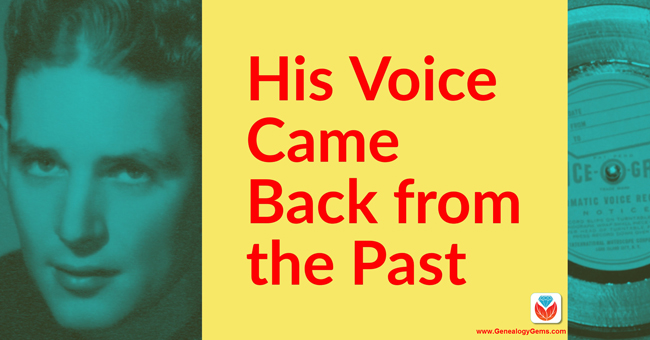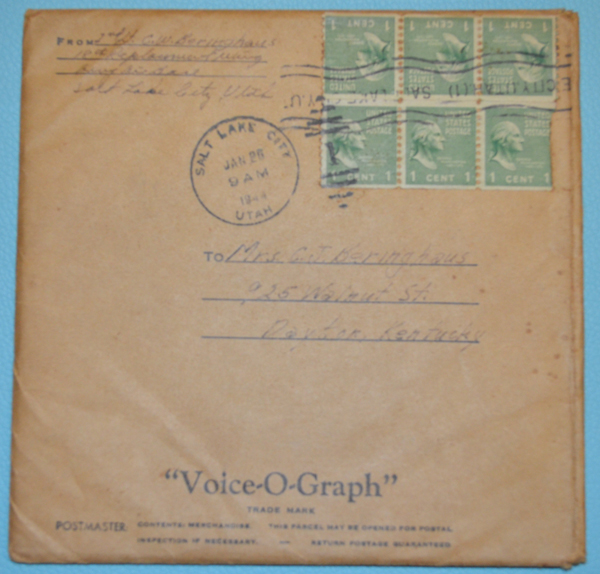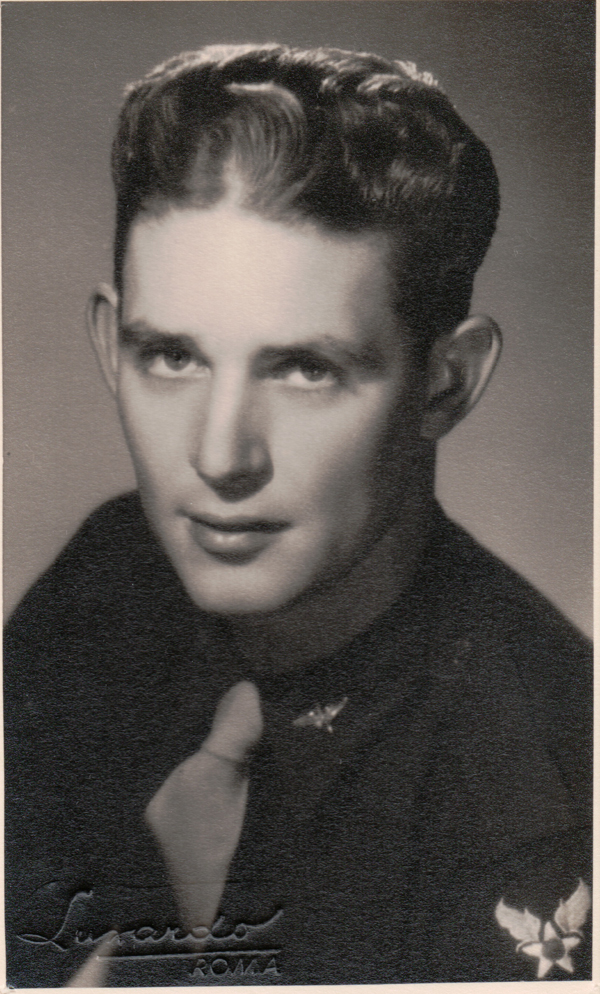Can you imagine the excitement of stumbling into family history memorabilia that included a voice from long ago on a Voice-O-Graph record? Sometimes the challenge is not finding a family history treasure, but instead it is “unlocking” its precious contents. Here’s one Gem’s story and her request for help. Being a podcaster came in very handy in answering this email!

Voice-O-Graph Brings Her Father’s Voice Back
From our Genealogy Gems reader and podcast listener:
One of the things I love about Genealogy Gems is your appreciation of ephemera. I’m giddy when I find newspaper articles and documents for my family. I recently took everything out of my parents’ “picture closet” and found a treasure trove of documents and photos, such as the will my father wrote and sent to his parents when he entered the army air corps in WWII, the telegram my aunt sent when she eloped, and my grandfather’s WWI registration papers. I even found the scrap of paper on which my father wrote my mother’s phone number when he asked her on their first date, “Laura Lee HE5882”.
One of the items I found is a January 1944 “Voice-O-Graph” my father recorded and sent to my grandmother. It’s in the original envelope, too. I’m interested in having the recording digitized. The reason I seek guidance is that all of the websites for audio transfer services have pretty lurid landing pages. Even if it’s not possible to get a decent dub of the old record, I’d at least like to feel confident that I’d get the 78 back in one piece.
Any ideas? Thank you!
Lisa
Digitizing a Voice-O-Graph Record
Entrusting your precious Voice-O-Graph record with an unknown website service could be pretty unnerving. Anytime you ship something, there’s always a rish of damage or loss. Before sending away your precious heirloom, try these do-it-yourself methods to create a digital recording.
If you have several records to digitize, I usually suggest looking at purchasing your own turntable that can record to digital. I have one that looks like an old time radio. Here’s one that is on the lower cost end.
In Lisa’s case, it sounds like she has just one record to digitize. If she has a turntable that can play 78s, she can first try playing the records and recording the sound through her computer’s microphone, a handheld recorder, or a smartphone using a free app like Evernote that can record audio.
The next option would be to purchase a converter like this one. You plug your turntable into it, and then plug an external hard drive into the converter, and play and record.
By the way, if your voice-o-graph is a bit warped, this article offers help.
When I discovered an old reel-to-reel recording in my own family, I took it to our church sound system technician. They had new digital equipment, as well as also older equipment. They were able to easily record a digital version for me.
Lisa did eventually get the record digitized. Take a listen for yourself:
As you can hear, Lisa’s father’s recording has a lot of background noise. His voice is far off in the distance and could use some enhancement. But the first challenge was to get the record digitized.
Enhancing the Quality of the Voice-O-Graph Recording
Once you have created an mp3 recording, you can then try to improve the quality of the sound with a free software program called Audacity. Sound improvement is a series of fixes and edits that you apply to the audio file. It’s a gentle process of balancing the bringing forward of the voice while keeping noise tolerable. It’s definitely an art, and not a science. Initial improvements you can easily make include:
Removing “Clicks” – These appear as tall spikes on the audio track in Audacity. Carefully highlight them and delete.
Applying Noise Reduction – Apply noise reduction sparingly, and focus on the elements of the recording that are the most important to you. Noise reduction can add a sort of warped quality to the sound if applied too heavily. Apply just enough to remove unwanted noise that is getting in the way of the voice, while keeping distortion tolerable. You’ll hear a bit of this in my edited version of Lisa’s audio file below. The recording had deteriorated so much that a lot of what is said is lost. I opted to tolerate heavier nose reduction in order to make much more of the voice understandable.
Amplifying the Audio – Apply amplification to the entire track, and then go back and reduce amplification in the areas that do not include the voice. This can be a tedious process, but as you will hear in my version of the audio below, it can pay off.
The Man Behind the Voice
“My father (Capt. C. William Beringhaus) was in the 15th Air Force, 99th Bomb Group flying B-17s. This recording was made in Salt Lake City in January, 1944 just after he completed aviation cadet training in Lubbock, Texas. He was sent to Salt Lake as part of a pilot’s pool before being sent to Sioux City, Iowa for training in the B17.
Capt. C. William Beringhaus
In the recording it sounds like he says that he is in town and is making the recording because “Woody” made one. I believe Woody might have been Capt. Morris S. Wood, the bombardier. “

Do You have a Voice-O-Graph Recording?
While I have picked up a few Voice-o-Graph records complete with mailing envelopes at antique stores over the years, I’m not fortunate enough to have found one in my own family (at least not yet!).
Do you have a Voice-O-Graph recording in your family? Leave a Comment below and tell us about it. Where did you find it? Who’s voice is on the recording? And have you digitized it yet?
Read More About Preserving Your Family’s Memories
Get Photos Scanned without Getting Scammed
The Recommended File Formats for Long Term Preservation
Humidity and Your Family Archive: Why It Matters






I have recently found 2 original Voice o graphs sent by my father, Alf Steel, from Vancouver, Canada to his parents in New Zealand. He visited Canada, with a friend, on a working holiday in 1951-2. One is dated 2nd June 1951 and seems to have been made in Seattle. My father died in December 2015 and these were found in his effects. I have not yet dared to play these, but your article has been helpful in deciding what to do to hear them.
Thanks
Hello,
We recently found some homemade records that contain treasured voices from the past. We have since gotten the voices digitalized and were able to send to various family members. What I am interested in, is finding out more about the portable version of the Voice-o-graph. It was evident that the device was being passed around from family member to family member while recording. Do you have any idea of what this device is called and/or looked like?
I have just found two Voice O Graph recordings. I believe it is my mother’s voice, and she’s talking to me. How can I hear these? I have no clue as to how to do this. Thank you in advance for any help you can provide.
My mother-in-law has a voice o graph her husband sent her when he was in the Korean War. But are turn table won’t play it?😞
I have a handful of voice o graph’s from my fathers side of the family…. can I play them on my record player if it plays 78’s?? thank you.. julie
Dear Lisa,
I received three “Voice-O-Graph” recording of my father’s voice with the mailing envelopes from 1954 and 1956. (6 cents postage!) I was only 6 years and 8 years old when my father sent them to me in Michigan from Chicago. I do not remember receiving them nor listening to them. I immediately started crying when they were given to me. My father passed in 1992 before the digital age began, so if I could possible hear his voice again it would me the world to me!!! Thank you so much for your article! I would have no idea where to begin and it was very very helpful!! I just ordered the record player from Amazon so I have not listened or digitized them yet. I am hopeful that it will work!
Many thanks…
Sue M.
I have 2 Voice-O-Graph dated 1951. I tried playing them on a turntable but got no sound. How do I digitize them?
Hello All, I too have just come across two of them from my mom and her sister when they were very young. good to find others having one besides me. Thanks for the page. Lisa (too)